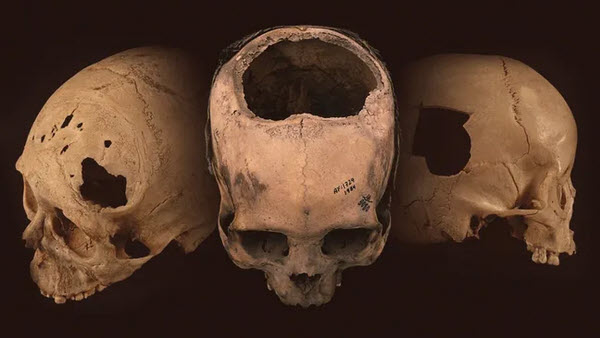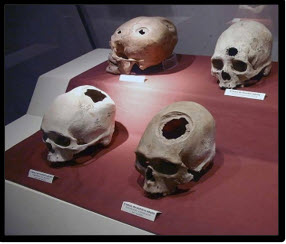
Source: Wikipedia, University of Miami.
By Paarth Mathur ✐
While Europe’s 19th-century surgeons struggled with a 50% survival rate for skull surgeries, the ancient Incas had been quietly achieving 90% success with similar procedures for thousands of years—a medical achievement systematically erased by colonial bias.
The Inca civilization, widely celebrated for its architectural marvels and sophisticated societal structures, also demonstrated remarkable expertise in medicine and surgery, a fact often overlooked in mainstream historical narratives. Among their most significant achievements was trepanation, the surgical practice of removing a section of the skull, which was used to treat head trauma, neurological conditions, and possibly spiritual ailments.
The oldest evidence of trepanation is a skull dating from 3000 B.C. from the region of Paracas. For Peru’s pre-Hispanic cultures there were obvious reasons for trepanation. Warfare was common among the Incas and, as mentioned before, resulted in severe fractures and head wounds due to the use of weapons like slings and clubs.
Despite evidence of high survival rates, early Western anthropologists largely dismissed the complexity of Inca medical knowledge. This dismissal of indigenous achievements highlights deeper colonial biases, particularly those linked to the Doctrine of Hemispheric Control, which positioned Latin America as a dependent and underdeveloped region in need of Western intervention. As modern scholarship revisits these ancient practices, a clearer picture emerges, one that demands the decolonization of medical history and anthropology.

Archaeological discoveries in Peru reveal that trepanation was widely practiced in the Inca and pre-Inca societies, dating back at least 2,000 years. Excavated skulls exhibit clean surgical cuts and evidence of healing, suggesting that patients often survived these operations. Recent studies indicate that up to 90% of trepanned individuals showed signs of bone regrowth, meaning they lived for months or even years after the procedure.
What made Inca trepanation so successful? Unlike their European counterparts, who often punctured the brain’s protective membrane, leading to fatal infections, Inca surgeons adapted their techniques to minimize damage and prevent infections. Inca surgeons were known as Hampicamayoc — Hampi meaning medicine or healing and Camayoc meaning specialist.
Although the word Hampi in compound words could have several meanings, it does suggest that medicine played a role during surgery. That is not surprising because the high percentage of recovery among patients with trepanned skulls indicates that the healer used medicinal plants to prevent infection and inflammation and possibly also analgesics to reduce pain during the operation.
Hampicamayoc employed scraping, drilling, and cutting methods, adjusting their approach based on the severity of the head injury, followed by the use of botanical antiseptics, such as coca leaves and other plant-based treatments, to reduce pain and fight off microbial infections.
They also used gold, silver, and other materials for skull repairs. On Moche and Chimú pottery, scenes are depicted that seem to represent a surgeon operating on a skull, not exclusive to contemporary medicine but rather a continuum of human medical progress.
Trepanation bears striking similarities to modern neurosurgical procedures such as craniotomy, as both techniques involve creating an opening in the skull to relieve pressure, treat head trauma, or access the brain for medical interventions. While trepanation was historically performed using rudimentary tools like obsidian knives and bone scrapers, modern craniotomy employs advanced surgical drills and imaging technology to ensure precision. Despite these technological differences, the core principles remain the same: minimizing damage to surrounding tissues, preventing infections, and promoting post-operative healing. The Incas, who pioneered trepanation with remarkable survival rates, unknowingly laid the groundwork for modern skull surgeries, proving surgical ingenuity.
 When compared to 19th-century European trepanation practices, where survival rates rarely exceeded 50%, the Incas appear to have outperformed even the most “modern” Western surgical techniques of their time, contradicting the notion that scientific progress only follows a linear path originating from the West.
When compared to 19th-century European trepanation practices, where survival rates rarely exceeded 50%, the Incas appear to have outperformed even the most “modern” Western surgical techniques of their time, contradicting the notion that scientific progress only follows a linear path originating from the West.
The information about Inca healers is not only prejudiced but also very incomplete. Since pre-Columbian South American civilizations did not have a writing system, there are only two main sources of information for studying Inca medicine. One source comes from archaeological findings, such as skeletal remains. These remains provide insights into diseases, surgical treatments, and medical customs like cranial deformation. The second source consists of written reports from the Spaniards who accompanied or followed the Spanish conquerors.
While these reports are valuable, they have some major limitations. One issue is that many of these reports were published years after the conquest, making them less reliable. Another problem is the bias of Spanish chroniclers, particularly Catholic priests. They often viewed Inca beliefs related to religion and magic as inferior or even as the work of the devil, downplaying Incas knowledge. Another reason is that the chroniclers in South America did not show the qualities which, for example, the chroniclers for the Aztec region had. This applies to many aspects of society but certainly also to medicine and the use of medicinal plants. Chroniclers like Sahagún (Franciscan missionary) and Hernández (Spanish physician and naturalist) recorded far more medicinal plants and gave much more information about Aztec medical abilities than those who reported about the Incas. That could be the reason that they did not observe trepanation.
 While it is now clear that trepanation was practiced by the Incas, there is no mention of it in the Spanish reports. Many systematic studies have also been performed on skulls found in the highlands of Peru, including the region around Cusco, where a large number of trepanned skulls have been found, in spite of the less favorable conditions for their preservation in these regions.
While it is now clear that trepanation was practiced by the Incas, there is no mention of it in the Spanish reports. Many systematic studies have also been performed on skulls found in the highlands of Peru, including the region around Cusco, where a large number of trepanned skulls have been found, in spite of the less favorable conditions for their preservation in these regions.
American anthropology frequently portrayed indigenous civilizations as primitive and incapable of scientific or medical innovation. This mindset mirrored the broader colonial narrative, which sought to justify U.S. intervention in Latin America by depicting its people as needing Western guidance. As a result, significant discoveries such as the Incas’ advanced medical techniques were either ignored, reframed as mere superstition, or attributed to European influence.
The Monroe Doctrine (1823), originally intended to prevent European intervention in Latin America, paradoxically enabled American scientific dominance in the region. American anthropologists, archaeologists, and collectors claimed authority over indigenous remains, reinforcing the idea that Latin America’s past was a resource to be studied but not necessarily respected.
Today, modern Bio-archaeology and medical research are finally giving proper recognition to Inca trepanation. Studies conducted on skeletal remains have validated the effectiveness of their surgical techniques and challenged outdated colonial biases. Scholars now argue that it is essential to decolonize anthropology and medicine, acknowledging that scientific and medical progress is not the exclusive domain of Western civilizations.
Recognizing the Incas as surgical pioneers not only corrects historical inaccuracies but also fosters a more inclusive understanding of global medical history. The study of Inca trepanation leads us to re-evaluate longstanding assumptions in Western medicine and anthropology. For too long, the Monroe Doctrine’s legacy of intellectual dominance has obscured indigenous achievements, framing them as anomalies rather than integral parts of human progress. As we continue to unearth the medical brilliance of ancient civilizations, we must also challenge the outdated perspectives that have long shaped historical narratives.
The legacy of the Incas serves as a reminder that knowledge, innovation, and scientific achievement are not the monopoly of any one civilization but the collective heritage of humanity.
Paarth Mathur is the author of Voices: Linguistic and Cultural Dynamics of the Refugee Population in the United States





